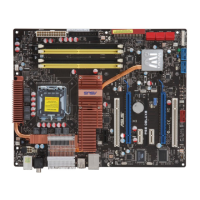
Do you have a question about the Asus P5E Deluxe - Ai Lifestyle Series Motherboard and is the answer not in the manual?
| Form Factor | ATX |
|---|---|
| Socket | LGA 775 |
| Chipset | Intel X38 |
| Memory Slots | 4 |
| Maximum Memory | 8 GB |
| Memory Type | DDR2 |
| SATA RAID | 0, 1, 5, 10 |
| Audio | 8-Channel |
| LAN Chipset | Marvell 88E8056 |
| IEEE 1394a | 2 |
| S/PDIF Out | Yes |
| Audio Ports | 6 |
| Dimensions (W x L) | 30.5 cm x 24.4 cm |
| Power Pin | 24-pin |
| PCI Express x4 | 1 |
| Memory Speed | 800/1066 MHz |
| Expansion Slots | 2 x PCI, 2 x PCIe x1, 2 x PCIe x16 |
| Storage Interface | 6 x SATA 3Gb/s |
| USB Ports | 12 |
| Max. LAN Speed | 1 Gbps |
| PS/2 | 1 x PS/2 keyboard, 1 x PS/2 mouse |
Introduction to the ASUS P5E Deluxe motherboard and its features.
Lists the items included in the motherboard package for user verification.
Highlights the key features and technologies supported by the motherboard.
Details the main product highlights and unique selling points of the motherboard.
Explains the ASUS AI Lifestyle features for enhanced user experience.
Describes the exclusive overclocking features for performance tuning.
Important precautions to take before installing motherboard components.
Provides a general overview of the motherboard layout and key components.
Illustrates the physical layout of the motherboard and component placement.
Lists the contents of various motherboard slots and onboard switches.
Information and instructions for installing and managing the CPU.
Step-by-step guide on how to correctly install the CPU into the socket.
Instructions for attaching the CPU heatsink and fan assembly.
Details on system memory, including installation and configuration.
Procedure for installing a memory module (DIMM) into the motherboard socket.
Information about different expansion slots and installing cards.
Steps for physically installing an expansion card into a slot.
Descriptions of the motherboard's rear panel and internal connectors.
Details and illustrations of the ports located on the motherboard's rear panel.
Details and illustrations of the internal connectors on the motherboard.
Guide for the initial power-on procedure and system startup checks.
Information on utilities for managing and updating the system BIOS.
How to use the ASUS Update utility to manage, save, and update the BIOS.
Guide to updating the BIOS using the built-in EZ Flash 2 utility.
Explanation of how to access and use the BIOS Setup utility.
Overview of the BIOS Setup utility's main menu screen and navigation.
Details the main menu items available at the top of the BIOS screen.
Explanation of the keys used for navigating within the BIOS Setup utility.
Overview of basic system information displayed in the BIOS Main menu.
Configuration options for Serial ATA devices connected to the motherboard.
Settings for configuring SATA devices, including AHCI and IDE modes.
Options for configuring overclocking-related settings for performance tuning.
Details on settings for CPU overclocking and system performance tuning.
Settings for CPU, chipset, and other system devices.
Information and settings related to the CPU and its features.
Options to enable or disable various onboard devices like audio and LAN.
Settings for Advanced Power Management (APM) features.
Configuration options for power management features like AC power loss.
Settings for configuring system boot options and device priority.
Specifies the sequence of devices for system boot priority.
Settings for system security, including supervisor and user passwords.
Access to special function utilities like BIOS update and O.C. Profile.
Utility for easily updating the BIOS without needing a bootable diskette.
Allows users to store and load multiple BIOS settings for overclocking.
Guidance on installing compatible operating systems on the motherboard.
Details on the contents of the support DVD, including drivers and applications.
Lists available device drivers for installation from the support DVD.
Lists software applications and utilities available on the support DVD.
Detailed information on specific software applications included on the support DVD.
Information on the SoundMAX audio utility for high-quality audio experience.
Utility for monitoring computer vital components like fan speed and temperature.
Allows launching utilities like AI Gear, AI Booster, AI Nap, and Q-Fan 2.
Explanation of RAID levels and how to configure them.
Defines different RAID levels (0, 1, 5, 10) and their characteristics.
Steps to configure RAID sets using Intel Matrix Storage Manager in BIOS.
Instructions for creating a RAID driver disk for OS installation.
Steps to create a RAID driver disk using BIOS setup.
Steps to create a RAID driver disk from within the Windows operating system.
Introduction to ATI CrossFire technology and its support on the motherboard.
Lists the hardware and system requirements for ATI CrossFire setup.
Step-by-step guide for installing master and slave graphics cards.
Information on installing software related to ATI CrossFire technology.
Instructions for installing the necessary device drivers for graphics cards.
Guide on how to use the Catalyst Control Center for display settings.
Information about the Intel EM64T feature and its compatibility.
Details on Intel SpeedStep Technology for power management and performance.
Lists the system requirements for using the Intel SpeedStep Technology.
Explanation of Intel Hyper-Threading Technology and its usage.